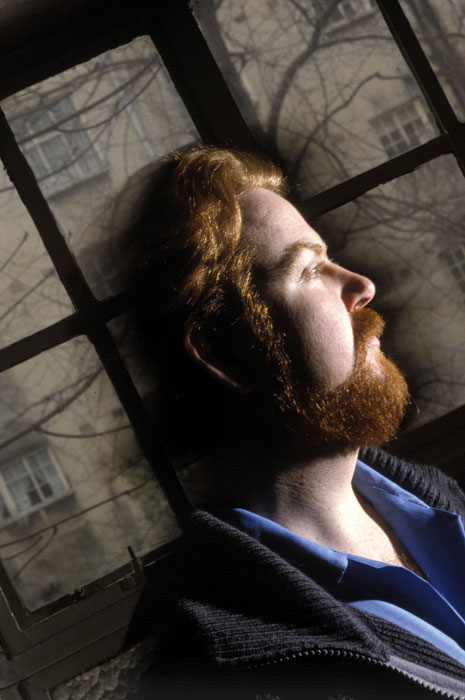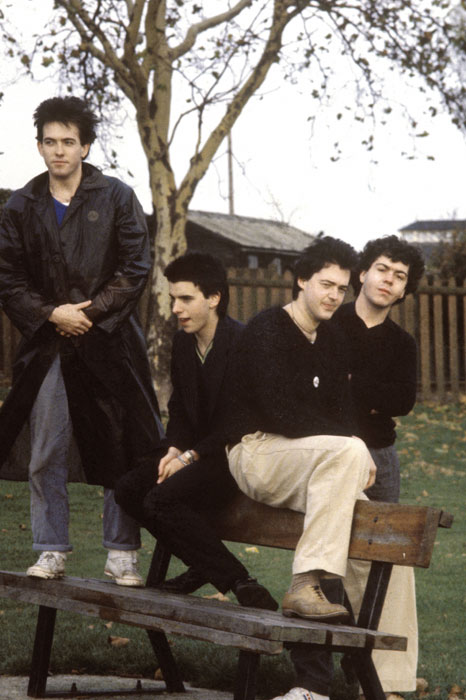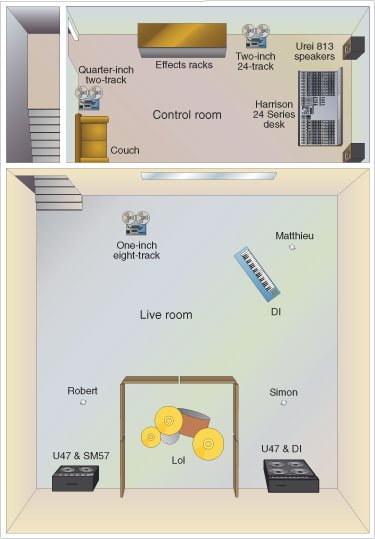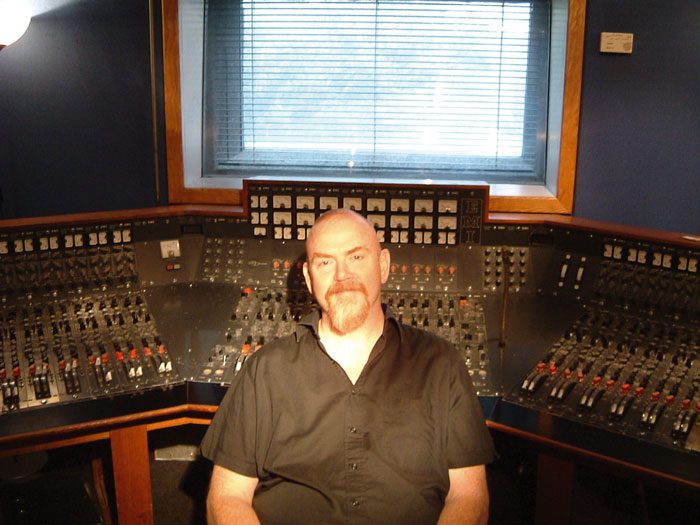December 2004 - Sound On Sound (UK)
CLASSIC TRACKS: The
Cure 'A Forest'
Producers: Robert Smith, Mike Hedges
Published in SOS December 2004
Technique : Classic Tracks

Mike Hedges made his debut as a producer with one of the Cure's most enduring
singles. 'A Forest' and the accompanying Seventeen Seconds album used his and
the band's creativity in the studio to the full.
Richard Buskin
As famous for their depressing dirges
as for singer-guitarist Robert Smith's deathly visage, the Cure rode the
post-punk wave during the late 1970s and early 1980s as leading architects of
goth
rock. By the time the genre hit its stride in the mid-'80s, the band had moved
on to more mainstream pastures; but their second album Seventeen Seconds, and
especially the single 'A Forest', were the definitive
goth
recordings. Hey, even co-producer/engineer Mike Hedges sported eyeliner back in
the spring of 1980...
Around the time that the Seventeen Seconds sessions began in late 1979, bassist
Greg Dempsey left to join the Associates and was replaced by Simon Gallup, while
keyboard player Matthieu
Hartley was added to a line-up that also included Smith and drummer Laurence
'Lol' Tolhurst,
fleshing out the group's sound and enabling it to be more experimental and...
well, downright gloomy. This, after all, is what lyricist Robert Smith was
after: creating a consistently dark and evocative mood by way of sparse musical
arrangements and plaintive vocals buried deep within the reverb-laden mix.
classic tracks 5.s
"It wasn't something to elate you, it was something to really make you think,"
says Hedges, who would withdraw from the Cure fold after co-producing and
engineering the band's third album, Faith, because, by his own admission, "it
was so introspective and so depressing, it did us all in. It was a dark, dark,
dark record, and when you work on something like that you're not laughing and
smiling the whole time. You get heavily affected by the music, and by the time
we finished it I was on the verge of a nervous breakdown. God, was I depressed.
I mean, we didn't fight or anything in the studio. It was just bloody miserable.
You know, we'd have a drink and relax between sessions, but we took the
recordings themselves very seriously. Robert had a cathartic outpouring of
emotions on that album, and because of that it affected all of us."
That was in 1981, yet the previous year a little commercialism also wasn't out
of the question, as demonstrated by the slightly more pop-edged Seventeen
Seconds album and its breakout single, 'A Forest'. Although the Cure's first UK
hit only peaked at number 31, it would go on to have a lasting influence,
becoming almost a signature tune for the band. An exercise in minimalist
entrancement, the song actually earned the Cure an appearance on BBC1's Top Of
The Pops, while Seventeen Seconds made it to number 20 on the British album
charts.
Starting Out
Mike Hedges was largely responsible for this record's innovative yet clean-cut
production sound, having initially worked with the Cure on his first engineering
project a few years earlier. Until then a tea boy, tape-op and assistant at
Morgan Studios in Willesden, North London, he had jumped at the opportunity to
work with the new band — at that time consisting of just Smith, Dempsey and
Tolhurst
— when other in-house staff declined the offer. Indeed, the fact that many of
his elders considered punk both destructive and beneath them paved the way for
Mike Hedges to carve out his own niche by way of a musical form that truly
inspired him.
classic tracks 1.s

Photo: Barry
Marsden
Mike Hedges as he appeared in the early '80s.
'Killing An Arab' was the debut single that resulted from his first
collaboration with the Cure, and after leaving Morgan in 1981 to open his own
facility, the Playground, in nearby Camden Town, Hedges continued working with
the Cure as well as the Associates and Siouxsie and the Banshees. His subsequent
credits have included U2, Dido, the Manic Street Preachers, Travis, Texas and
the Beautiful South, while in 2002-2003 he took over the legendary
Wessex
Studios before property developers sadly created an apartment block out of it.
While he is currently involved with 2kHz, Hedges' main domain is now Westside
Studios, which houses some of his classic analogue gear including the 60-input
EMI TG MkII
valve console on which Pink Floyd recorded Dark Side Of The Moon in Abbey Road's
Studio Two.
It was on a 32-channel Harrison 24 series desk inside Morgan's Studio One that
he recorded the Cure during the late '70s and early '80s, alongside a 24-track
Studer
A80 and Urei
813 monitors.
"It was a very large studio, high and rectangular," he now recalls. "The control
room was up some stairs at one end, with the desk to the left of a window that
looked down on the main room. For the backing tracks on Seventeen Seconds, the
band essentially played in there as a live unit, with the drums in the centre of
the back wall, bass to the left, guitar to the right and the keyboards
immediately in front of us, under the window."
Keen To Experiment
While Mike Hedges had engineered the band's first album Three Imaginary Boys, it
was produced by former Polydor
A&R man Chris Parry, who had signed the Cure to his own Fiction record label.
The Seventeen Seconds project marked Hedges' debut as a producer, albeit in
conjunction with Robert Smith.
"Robert said to me he thought he and I could actually produce the record more to
his liking than if a third party did it, and he wanted the freedom that
afforded," Hedges explains. "At the same time, I wanted to get a more unusual
sound than that on the first album, something different to the standard
recording. As an engineer I was very, very keen to experiment, and Robert
encouraged me to do this, so as co-producers he was in charge of the musical
direction while I took care of the sonic direction. The band members were very
individual, so I wanted a really individual sound, and this led to quite a bit
of experimenting and equipment changes. Robert got a better guitar amp and a
better guitar — I think he changed to a Fender
Jazzmaster
— and he also had the Woolworths Top Twenty guitar that he'd used on the first
album. You didn't want to lean on that thing too heavily.
"It really was the drum sound that largely defined the album's sonic direction,"
continues Hedges, whose assistant Mike Dutton was credited as co-engineer. "The
C-ducer
contact mic
had just arrived on the scene at that time, and after testing it in another
studio I decided to mic
the entire drum kit with C-ducers.
I had initially tested the mic
on other instruments, not drums, but then when I briefly tested it on drums I
thought 'God, they sound fantastic like that.' There's absolutely no spill
between the different drums when you use a C-ducer
— each drum is completely separate. Every part of the kit was therefore
miked
with C-ducers
— kick, snare, hi-hat, three or four
Rototoms
and two crash cymbals — and this gave us a very, very contained drum sound with
no space at all. Everything is right up close, there's no ambience whatsoever,
and we then used reverbs and delays to give us the shapes and the sizes. I think
the fact that the drums had such little ambience and were so sterile and cold
really set up the mood we loved.
"Having recorded the cymbals this way, we also did cymbal overdubs because we
wanted a very, very heavily compressed sound that had total sustain. You can
hear that on a couple of songs, including 'Play For Today' — when the cymbals
crash there's a click followed by a long, long sustaining cymbal, which is three
1176 compressors in a row. It hisses for about 20 seconds."
Three Notes Is A Crowd
Mike Hedges doesn't recall hearing any demos for Seventeen Seconds — having
already routined
and possibly played it live, the band would just run through a number in the
studio and then dive straight in. Still, although the original plan was to lay
down all the backing tracks before recording overdubs, this wasn't strictly
adhered to: once a backing track was deemed satisfactory, there was a tendency
to take it a little further and do some overdubs.

Photo: Gabor
Scott / Redferns
The Cure line-up that recorded Seventeen Seconds was together for barely a year.
From left: Robert Smith, Simon Gallup,
Matthieu
Hartley and Lol Tolhurst.
"I remember the guitar parts being very easy," Hedges says. "Robert had most of
them worked out and the overdubs were simple — they were double-tracks, guitars
with more effects or embellishments here and there. However, there were very few
over-overdubs. They were mainly just single overdubs, and there was very, very
little comping
on that album. In terms of the vocals, which Robert performed into a Neumann
FET
47, we'd do just one track and if it wasn't right we'd redo it, and if it still
wasn't right we'd maybe drop in one or two bits, but generally there was very
little comping.
We didn't really have the time. There might have been two guitar tracks
comped
into one and there might have been two vocal tracks
comped
into one, but generally everything was as played or as sung.
"The backing tracks weren't easy to record. To actually get the bass and drums
very tight with each other was difficult, but again this was down to time. We
were spending something like an hour on each backing track, not much more, and
the time pressure didn't help. Saying, 'Right, this is it, we have to get the
track down now,' obviously doesn't make for a relaxed session, and recording
some of those backing tracks was like death by mid-tempo. There's nothing worse
than doing a mid-tempo track that's got a lot of space in it. To get the feel
right is really difficult to do."
Whereas Simon Gallup's bass was hooked up to an
Ampeg
SVT,
Robert Smith's guitar went through a Roland JC120, close-miked
with a Shure
SM57 while a Neumann U47 was positioned about three feet away.
Matthieu
Hartley played a DI'd
synth.
"He had single-note parts, and this became a bone of contention during
recording," Hedges recalls. "Robert was very keen — and I was totally happy to
back him up on this — for the keyboard parts to be single-note lines and not
chords. Occasionally there were two-note chords, but these were a rarity,
because the single-note approach was a rule to keep it simple. Well,
Matthieu
put up with this, but he eventually became less and less
enamoured
with it, especially once the band embarked on its first world tour following the
album's release. I mean, standing on stage and using one finger to play the
keyboard lines had to be frustrating. He had another nine fingers to play with!
And it also didn't help that he only had a cheap little Roland analogue
keyboard." In light of all this, it's probably not surprising that Hartley quit
the band following the Australian leg of the tour, after which the Cure
continued without him.
Slightly Warped
"I got heavily into choruses and
flangers on the album," continues
Mike Hedges. "I basically collected every single
flanger
and chorus I could find anywhere in the studio and borrowed them from people
with new units, and for 'A Forest' I think we had as many as seven
flangers
running on 'envelope', flanging on the shape of the sound coming in rather than
as a constant. Aside from bass and guitars, you can particularly hear it on the
cymbal crashes, which dive away immediately following the hits. You see, Robert
was heavily into choruses — he had a JC120, and so if you had a U47 on one
speaker of the amp and a 57 on the other, you then had a stereo chorus, which
was great. We loved the chorus, and because of that I originally started playing
flangers
to do choruses until I realised
that flangers
were fantastic as well, at which point we actually started using the
flangers
as flangers.
These made the overall sound slightly warped — nothing was quite natural, adding
to the underlying atmosphere."
classic tracks 3

The layout of Morgan Studios during the recording of the Seventeen Seconds
album.
Then there was the tape delay, and plenty of it. "Oh, we were really into that,"
Hedges agrees. "With the machine you'd go into the left, out of the left, and
out of the left into the right. The left would then go to the desk and the right
would go to the desk, so you'd have two different delays on a stereo machine,
and obviously when you spun it you could either have one delay working or both
delays or fade between the two. That gave you the effect of it going
jang-jang,
jang-jang-jang-jang-jang-jang-jang
— you could actually have a half-speed delay and then the double-speed one would
come through it as you switched the other fader on. I also remember us
experimenting with sound on sound on tape delays. There'd be a big rush, a big
build-up of sound on top of itself, getting really messy, and that was great,
kind of like a reggae thing. Reggae used that quite a lot.
"There were very few effects at the time. You did have things like Harmonizers
just coming in, flangers
were quite unusual and there were all the old analogue tape delays, but they all
did pretty much the same thing. Chorus, delays, reverbs,
flangers
— there wasn't very much else. These days, since it's very easy to get unusual
sounds, you have to be a bit more selective with what you actually use. There
was less in the drawer when you opened it back then, whereas now it's completely
full of stuff and you have to decide 'Well, I want this,' or 'I want that.'
Also, because it was all analogue, there'd be very unusual sounds that you
wouldn't expect, whereas a lot of digital effects these days tend to be
surprisingly ordinary for what they do. In the old days we'd use delays on
delays, tap the tape delays that went through so that it did wow and flutter to
get really unusual sounds happening, and also use lots of backwards reverb and
other backwards things on the tape machine.
"When you record on a tape machine you have the sync [record] head and the safe
head [ie.
the playback head in safe mode, where recording was disabled]. You record in
sync and turn back to safe for slightly higher quality when mixing, but while
Mike Dutton was switching through them he left the hi-hat track in sync, so it
was earlier than everything else. I can't remember which track we used that on,
but I know it sounded fantastic."
Looping The Loop
Tape loops played an instrinsic
role during the Seventeen Seconds sessions, the bass and drums being played into
a one-inch, eight-track Studer
before some very long loops were created — not one- or two-bar loops, oh no, but
16- or 32-bar loops, which meant recording onto the tape, cutting said tape as a
loop and then running it all the way around the studio.
"We'd run it off the tape heads, through the pinch rollers, about 10 feet away
to a pencil taped onto a mic
stand, then another 10 feet to another pencil and mic
stand, and so on, all the way around the room," Hedges remembers. "You have to
remember, we were running the tape at 15 inches per second, so when you have a
16-bar loop at 120 beats per minute it's going to be 30 or 40 feet long. A
couple of the songs were recorded as a loop, and we then had these running as a
loop, recorded them onto the 24-track and then overdubbed onto them using the
24-track.
"When you're playing with these very long loops you have to get the tension just
right, because otherwise the tape flips and you'll get wow and flutter. The
funny thing is, the barrels of
Chinagraph pencils are coated
with a slightly slippery paint, and that's actually better than using the metal
of a mic
stand. At the same time, up-and-down tape slippage wasn't much of a problem
using this technique. We used to attach those little round plastic editing-tape
boxes underneath, and the tape would rest on them and, so long as the pencils
were at the right height, not really want to slide up and down too much. Also,
the tension was quite high, so there was very little droop in the tape. It was
fairly taut."
Quick Fire
It should be taken into account that, thanks to budgetary constraints, the
entire Seventeen Seconds album took a total of seven days to record and mix,
which, although about 40 percent longer than the time accorded the preceding
Three Imaginary Boys, still speaks volumes for the ingenuity, craft and
rapid-fire innovation of the musicians and technicians.
"When you're taught to do a job in a specific way, it's not necessarily frowned
upon if you do it differently, but it's also not technically correct, so it was
kind of exciting to push the envelope back then," Mike Hedges remarks. "These
days, with all the equipment we have, it's far more difficult to do something
unusual. In fact, the strange thing is, during the last 25 years people have got
safer and safer in a funny sort of way. Given the way we've come through the
different styles of music, songs have to sound a certain way to fit in with the
genre. It seems like a particular rock band has to have a certain snare sound
while a particular R&B band has to have a certain stripped-out bass drum, and
it's quite odd how people seem to have to fit in more and more with a niche.
They angle everything towards that and they don't really experiment — they
experiment within that niche but not really outside it. That's just the way the
music business has gone, whereas during the late '70s and early '80s the niches
weren't there. We weren't trying to make the Cure's sound fit in with anything
else. We were just making the sound of the band. This was them, this was how
they sounded and it didn't matter what anyone else sounded like. It was their
own individual thing."
Among the last songs to be recorded for the album was 'A Forest' which,
according to Hedges, he and Smith knew was going to be the most difficult. "We
wanted it to be quite ornate," he says, "and it ended up being the most produced
track on the album. To me it always sounded like a single. We all thought it was
an amazing song — I loved the guitar line — but we also figured it would take a
bit more work than the others. The other songs immediately sounded more
complete, whereas 'A Forest' sounded like it did need several overdubs."
After the backing track had been recorded live, individual parts were replaced
as necessary, Robert Smith laid down his vocal, and then it was on to the mix.
"Practically the whole album was mixed on the second-to-last day, and then the
mix for 'A Forest' took up a good part of the final day," Hedges recalls. "All
things considered, that was very, very extravagant."
The track would, in fact, be subjected to several subsequent remixes, although
not until much later, not with Mike Hedges' involvement and not even from the
original recording. "For some reason the original
multitracks
of that particular song were stored for a while in the Fiction Records offices
and at some point they were lost," he states. "The band therefore had to
re-record the song."
Athletic Production
So much for all the effort. Still, among Hedges' abiding memories of the
Seventeen Seconds sessions was "a lot of drinking by all apart from the
engineer/co-producer. I learned very, very early on in my career that I can't
drink alcohol or take any recreational drugs while I'm working," he comments.
"I'm just not physically or mentally able to hold everything together."

Mike Hedges today, with his ex-Abbey Road EMI console, now housed at Westside
Studios.
So, what was it like to be only the sober guy at the party? "It was actually
quite good," comes the reply. "Robert knew his limit and he stuck to it, and it
was within his limit to be able to work and actually do a really good job of it.
The others, meanwhile, would finish their parts and get so off their faces that
they'd sort of fade out of the way because they couldn't stand up. Once they
were told 'You've finished your bits for today,' they'd really, really go for
it, and if their drinking ever encroached on the recording itself we'd just stop
that particular part and carry on the next day. You see, they were virtually
living in the studio — they slept on the floor of the studio — because with such
a limited time we'd be working 16 or 17 hours a day.
"Things are very different now. They're so strict. If the band or producer mess
up these days it could spell the end of the band's career, so people don't take
risks any more. It's like a military exercise. Obviously, you want to have as
much fun in the studio as you possibly can, but you've got to get it right. Not
only are the budgets much bigger — Seventeen Seconds probably cost between
£2,000 and £3,000 to produce — but the pressure's also much more than it used to
be. With all of the recordings in those days there was very little A&R input;
almost none. You were pretty much left to it, and when A&R did turn up you'd
sort of down tools and look around until they went away. In fact, Chris Parry
did once say to me that he thought the Cure should be working with a more
athletic producer, because every time he came to the studio I was messing about.
What I would have liked to say to him was 'Well, actually we were messing about
because you were in the studio. We just wanted you to go away!'
"As it happens, Chris Parry was very, very relaxed. We said we wanted to do it
on our own and he pretty much left us to it. He came in once or twice.
Generally, in those days, when it came to recording the Cure, the Associates and
Siouxsie and the Banshees, we just did it. We recorded it and we delivered it.
We didn't actually know what the budget was, we were just told 'Right, you've
got five days to do it,' or three weeks sometimes, and without the pressure of
having to do a certain style of record we just did what felt right at the time."
Going Back
Motivated by this interview, Mike Hedges sat and listened to 'A Forest' for the
first time in about 15 years and was pleasantly surprised by what he heard. "It
actually sounds pretty good," he says. "We recorded very quick so I think we
could have got a better sound, but it's certainly got a character. The album
itself was very, very individual and it still stands out after all this time. I
don't think it sounds dated, and I can't say that about certain other albums
with which I was involved back in the 1980s..."
Published in SOS December 2004




